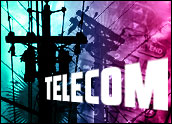
Convergence has been an ongoing goal for telecommunications suppliers in recent years. Today, cable companies sell not only video but also Internet access and telecommunications services. Recently, they have begun to get ready to deliver wireless services, which would enable them to deliver a quadruple bundle.
In a noteworthy development, four companies — Comcast Corporation, Time Warner Cable — a unit of Time Warner Inc., Cox Communications and Advance/Newhouse Communications — have begun working with Sprint Nextel Corp. to develop wireless services in 2006. “The cable companies have been talking about getting into the wireless market for about three years and now think that they have a business model that makes sense for them,” said Michael Paxton, a senior analyst with In/Stat.
Future Is Bright
Cable television companies are interested in the wireless market because it has been extremely fast growing. Among the covet 17-24 demographic, wireless has become a primary way to communicate. In fact, wireless services’ have become so popular that in 2005, wireless users in the U.S. passed wired ones for the first time in history, according to In-Stat. The future is bright because technical advances are making it easier for wireless companies to deliver multimedia services.
Technical advances have also made it simpler for cable companies to enter this market. The notion of carriers piggybacking on another one’s network, something common with wired services, has started to become more common in the wireless space. This is the model that Sprint and the cable companies plan to follow as they develop their services.
Broadening for Benefits
Cable companies see a number of potential benefits from broadened their service lines. Expanding their product lines is one way to lower service pricing. Because they are able to write their expenses (administration, marketing) over a larger base of services, they are able to lower those costs and pass them on to customers.
Another plus is the bundled services can tighten the bond to their customers. Telecommunications service providers believe that when users receive more than one service, they are less likely to switch to a competitor. Such changes, called churn, represent a significant problem for carriers: in highly competitive metropolitan markets as many as 20 percent of customers swap out their services each month.
Customers do not switch as often because bundles offers them benefits, such as simpler billing (consumers pay one bill rather than two, three, or four) and lower pricing. About a year ago, Bob Egan, director of emerging technologies at The Tower Group, switched his home telecom and cable television services to a bundled system. “The bundle cut my monthly communications charges by about 20 percent,” he said.
Bundling also offers cable companies the opportunity to develop new premium services. They envision providing live cable broadcasts over handheld mobile devices to customers who may be away from home.
A Logical Union
The five-team partnership seems quite natural. “Cable companies wanted to get into the wireless space but the other major network providers are already affiliated with wired telecommunications services providers, while Sprint is independent,” noted Jeff Kagan, an independent telecommunications analyst.
The new venture is being set up as a joint venture. Sprint Nextel will invest US$100 million in the project, and the four cable providers will contribute another $25 million each. The agreement runs for 20 years and is mutually exclusive for three years. The companies have not outlined any concrete plans for the type of services they will offer, how they will be priced, or when they will be available. “The cable companies are in trail mode now and should have their wireless services operating by the end of 2006,” predicted In-Stat’s Paxton.
Once those services come online, Sprint is expected to gain the most from the venture. “Sprint has been moving more into the wholesale side of the wireless market and the agreements mean at t the very least, more traffic will flow over its network,” Kagan told TechNewsWorld.
Looking to Grow
Just how much traffic is unclear. The cable companies have moved into wired telecommunications but are not top players. “Right now, cable companies have about 4 million telecommunications customers, which is a significant base, but there are 115 million telecommunications users in the U.S.,” noted In-Stat’s Paxton.
In addition to marketing challenges, cable companies must tackle some logistical problems. “Telecommunications billing systems are large, complex entities that have to be integrated to support the new services,” The Tower Group’s Egan told TechNewsWorld. The work may be done quickly for consumer accounts but may take time for corporate customers that often have multiple locations and a variety of billing agreements with carriers.
While seemingly alluring, the new bundled services may not deliver many of the potential benefits to cable companies. Initially, there will be little integration between cable company and wireless networks, so carriers may not realize some of the expected cost reductions.
Adding to the Repertoire
Also, the telcos have been searching for ways to add video content to their repertoire and also offer four services. Verizon forged a reselling partnership with DirectTV Inc., which relies on satellite transmission to deliver its services. SBC Communications has a similar arrangement with EchoStar Communications, which runs the Dish satellite network.
In addition, telecommunications companies are beginning to build out their networks and offer video over IP services. In September, Verizon launched a fiber-optic video service in Keller, Texas, and SBC received approval from the Public Utility Commission of Texas to launch its own video service in the San Antonio, Texas area this year.
The race between telecommunications and cable companies to broaden their services ranges has begun, and the latter seems to have jumped out to an early lead. “Because they do not have to put all of the network infrastructure in place, the cable companies should be able to roll out wireless services faster than the telcos can deliver video services,” noted In-Stat’s Paxton.











































